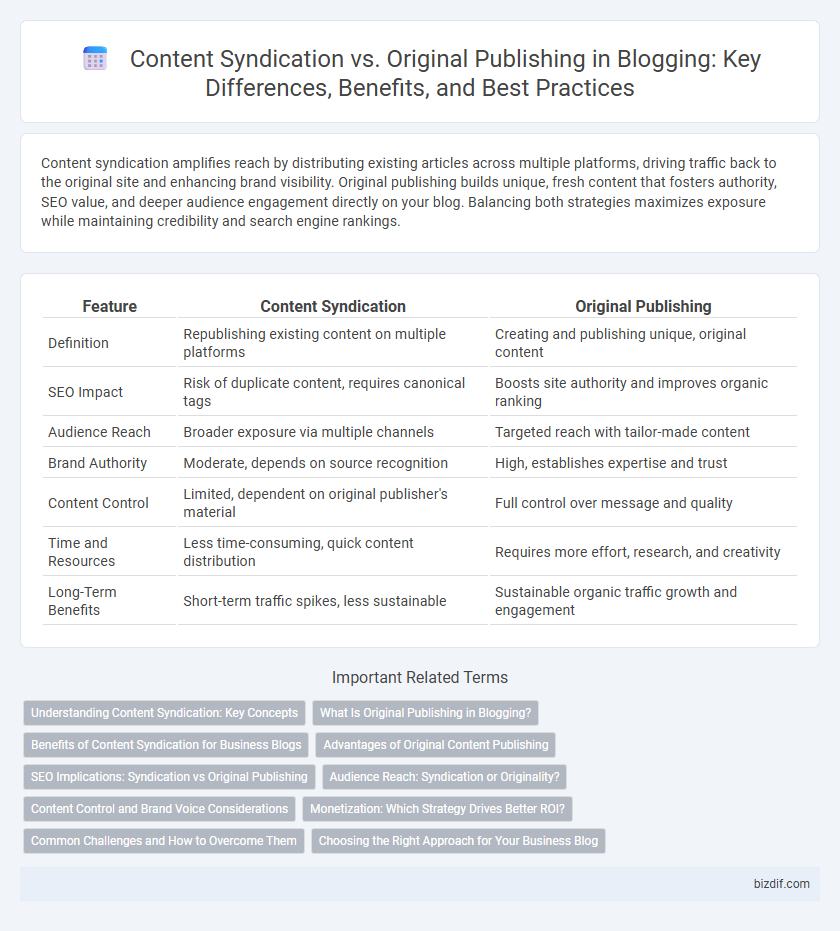Content syndication amplifies reach by distributing existing articles across multiple platforms, driving traffic back to the original site and enhancing brand visibility. Original publishing builds unique, fresh content that fosters authority, SEO value, and deeper audience engagement directly on your blog. Balancing both strategies maximizes exposure while maintaining credibility and search engine rankings.
Table of Comparison
| Feature | Content Syndication | Original Publishing |
|---|---|---|
| Definition | Republishing existing content on multiple platforms | Creating and publishing unique, original content |
| SEO Impact | Risk of duplicate content, requires canonical tags | Boosts site authority and improves organic ranking |
| Audience Reach | Broader exposure via multiple channels | Targeted reach with tailor-made content |
| Brand Authority | Moderate, depends on source recognition | High, establishes expertise and trust |
| Content Control | Limited, dependent on original publisher's material | Full control over message and quality |
| Time and Resources | Less time-consuming, quick content distribution | Requires more effort, research, and creativity |
| Long-Term Benefits | Short-term traffic spikes, less sustainable | Sustainable organic traffic growth and engagement |
Understanding Content Syndication: Key Concepts
Content syndication involves republishing existing articles or blog posts on third-party platforms to increase reach and drive traffic back to the original website. This strategy enhances brand visibility by exposing content to broader, often more targeted audiences without creating new material. Key concepts include maintaining canonical links to avoid duplicate content issues and selecting reputable syndication partners to preserve SEO value.
What Is Original Publishing in Blogging?
Original publishing in blogging refers to creating and sharing unique, firsthand content that reflects the author's authentic voice and expertise. It enhances search engine rankings by offering exclusive value and helps establish the blog as a trusted authority within its niche. Prioritizing original publishing drives higher engagement and long-term audience loyalty compared to content syndication.
Benefits of Content Syndication for Business Blogs
Content syndication boosts business blog visibility by distributing articles across multiple high-traffic platforms, increasing reach without the need for constant original content creation. It enhances SEO through quality backlinks, driving organic traffic and improving search engine rankings. Syndicated content also accelerates brand awareness and credibility by exposing the blog to diverse audiences in relevant industry niches.
Advantages of Original Content Publishing
Original content publishing enhances SEO performance by providing unique, keyword-rich material that search engines prioritize over duplicated content. It establishes brand authority and trust among readers, as authentic insights and perspectives resonate more effectively. Moreover, original content encourages higher engagement and natural backlinks, driving sustained organic traffic growth.
SEO Implications: Syndication vs Original Publishing
Content syndication can expand reach and drive traffic by republishing articles on multiple platforms but may lead to duplicate content issues that harm SEO rankings if not properly managed with canonical tags. Original publishing enhances a website's authority and search engine visibility by offering unique, high-quality content that attracts backlinks and improves domain ranking. Prioritizing original content while using syndication strategically ensures optimal SEO benefits without compromising search engine integrity.
Audience Reach: Syndication or Originality?
Content syndication amplifies audience reach by distributing articles across multiple high-traffic platforms, increasing visibility beyond the original site's followers. Original publishing strengthens brand authority and nurtures a dedicated audience by offering unique, tailored insights that differentiate from syndicated content. Balancing syndication for exposure and original content for authenticity optimizes long-term audience growth and engagement in blogging.
Content Control and Brand Voice Considerations
Content syndication allows broader reach but often sacrifices control over brand voice and content presentation, risking dilution of messaging consistency. Original publishing ensures complete authority over content quality, tone, and alignment with brand identity, fostering a cohesive brand experience. Maintaining distinct brand voice through original content supports stronger audience engagement and long-term brand equity.
Monetization: Which Strategy Drives Better ROI?
Content syndication boosts ROI by expanding reach and driving consistent traffic with minimal effort, while original publishing requires higher initial investment but offers greater control over monetization channels such as ad placements and affiliate marketing. Syndicated content leverages established platforms to generate quicker revenue streams through sponsored posts and display ads. Original content drives long-term brand authority and premium monetization opportunities, including exclusive partnerships and high-value conversions.
Common Challenges and How to Overcome Them
Content syndication often leads to duplicate content issues that can negatively impact SEO rankings, requiring the use of canonical tags or noindex directives to maintain originality. Original publishing demands consistent quality and unique insights, which can be time-consuming but builds stronger audience trust and authority. Balancing both strategies involves leveraging syndicated content to expand reach while consistently producing original posts to preserve brand identity and search engine performance.
Choosing the Right Approach for Your Business Blog
Content syndication amplifies your blog's reach by republishing articles on third-party platforms, driving referral traffic and boosting brand visibility. Original publishing fosters unique, proprietary content that enhances SEO rankings and establishes your blog as an authoritative source. Selecting the right approach depends on your business goals, audience engagement strategy, and resource allocation for consistent, high-quality content creation.
Content Syndication vs Original Publishing Infographic

 bizdif.com
bizdif.com